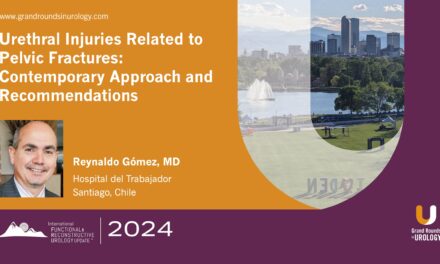Behfar Ehdaie, MD, MPH, presented “Transperineal Biopsy & Classification of Risk Using Novel Gleason Pattern Quantification” during the virtual 5th Global Summit on Precision Diagnosis and Treatment of Prostate Cancer in September 2021.
How to cite: Ehdaie, Behfar. “Transperineal Biopsy & Classification of Risk Using Novel Gleason Pattern Quantification.” September 2021. Accessed Apr 2025. https://grandroundsinurology.com/transperineal-biopsy-classification-of-risk-using-novel-gleason-pattern-quantification/
Transperineal Biopsy & Classification of Risk Using Novel Gleason Pattern Quantification – Summary
Behfar Ehdaie, MD, MPH, a urologic surgeon at Memorial Sloan Kettering Cancer Center in New York City, outlines the role of Gleason pattern quantification on prostate cancer outcomes. He explains data indicating biopsy pathology primary Gleason grade (GG) is prognostic of disease recurrence after treatment. Research showed an association between the total length of Gleason pattern 4 across all biopsy scores and worse pathologic outcomes among men with GG2 prostate cancer. Dr. Ehdaie explains the total length of Gleason pattern 4 across all biopsy cores best predicts risk of adverse pathology post radical prostatectomy (RP) compared to overall percentage or maximum percentage pattern 4 in a single core. Dr. Ehdaie then asserts that multi-parametric magnetic resonance imaging (mpMRI) and image-based tracking software has improved detection of higher grade prostate cancer. He displays data that show MR-targeted prostate biopsy improves detection of higher grade disease for men on active surveillance. Dr. Ehdaie explains 22 percent of patients on active surveillance experienced an increase in Prostate Imaging Reporting and Data System (PI-RADS) score on surveillance MRI, emphasizing that patients do experience changes in imaging that can be correlated with outcomes. He then explains the shift to transperineal biopsy and points out it enables systematic cores to be taken in a gridlike fashion that offers opportunity for standardization. He displays data comparing transperineal and transrectal biopsy that indicate transperineal prostate biopsy improves detection of higher-grade prostate cancer for men under active surveillance. Dr. Ehdaie concludes that transperineal biopsy may provide a standardized technique for better sampling and, consequently, better classification of risk, emphasizing that technology capable of transitioning from transrectal to transperineal prostate biopsy is key. Dr. Ehdaie concludes his talk by emphasizing that the incorporation of total biopsy length Gleason pattern 4 improves risk classification for men with GG2 and GG3 prostate cancer. This can help select patients for active surveillance and can develop triggers to recommend subsequent treatment. Additionally, Dr. Ehdaie reiterates that adding systematic biopsy cores to MR-targeted biopsy improves overall detection of higher-grade cancer, and seamless transition from transrectal to transperineal biopsy enables a template-based biopsy technique to standardize sampling for risk stratification.
The Virtual Global Summit on Precision Diagnosis and Treatment of Prostate Cancer brings together key international opinion leaders of every clinical subspecialty involved in patient care. This event is an integral part of the AdMeTech Foundation’s Annual Summit, which was established in 2016 and became seminal in shaping the state of the art and future vision for precision care. The goal of this event is three-fold: 1) Educating the key stakeholders; 2) Supporting a sustained cross-disciplinary dialogue and consensus on the best emerging clinical practices and research priorities; and 3) Expediting clinical adoption of promising novel diagnostics and therapeutics. For more educational activities from this virtual event, visit our collection page.
ABOUT THE AUTHOR
Behfar Ehdaie, MD, MPH, is a urologic surgeon at Memorial Sloan Kettering Cancer Center in New York City. He earned his medical degree at Georgetown University School of Medicine and then went on to a urology residency at the University of Virginia School of Medicine and a fellowship at Memorial Sloan Kettering Cancer Center. Dr. Ehdaie is an expert in minimally invasive surgical techniques for the treatment of urologic cancers, and has a particular interest in novel management of prostate cancer, kidney tumors, and bladder cancer. He has performed more than 500 MRI-guided prostate biopsies and is experienced in doing extensive lymph node removals at the time of prostate surgery. His research is focused on achieving prostate cancer cures while also preserving quality of life, and he is currently the principal investigator on a clinical trial of partial gland ablation that theoretically could allow patients with prostate cancer to receive effective treatment minus side effects like incontinence and erectile dysfunction. Dr. Ehdaie also aims to improve active surveillance by developing a large surveillance clinic that will use advanced imaging and biomarkers to detect cancer progression. Dr. Ehdaie has given presentations on prostate cancer throughout the United States and around the world, and has also published numerous articles and studies in peer-reviewed journals.




